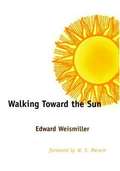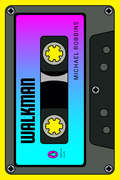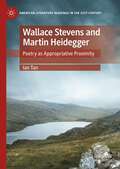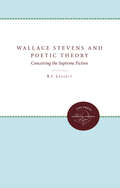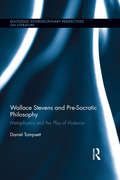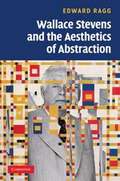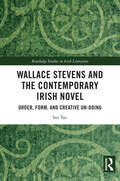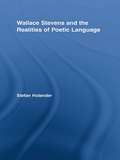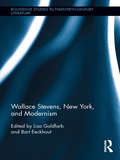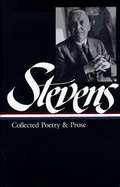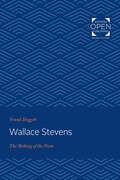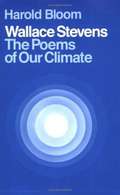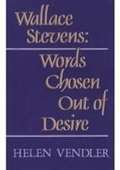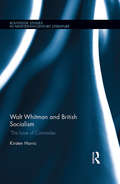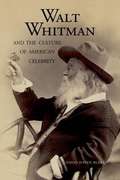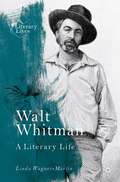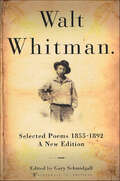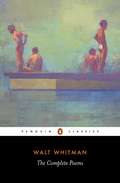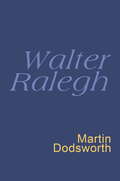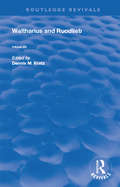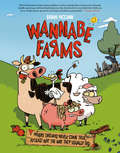- Table View
- List View
Walking toward the Sun
by Edward Ronald WeismillerIn 1936, twenty-year-old Edward Weismiller became the youngest poet to win the prestigious Yale Series of Younger Poets prize. Today, more than sixty years later, he retains that distinction. Yale University Press here reintroduces Edward Weismiller -- now the oldest living Younger Poet -- with the publication of his latest book of poetry. Weismiller's is "a talent that has kept faith with itself and its sources, " says W. S. Merwin, current judge of the Younger Poets Series. In Walking Toward the Sun, youthful lyricism has given way to plainness of speech -- even spareness. These poems are honest and unflinching, always striking in their prosody. They will remind some readers of Yeats, for they convey nobility in the face of old age, infirmity, and disappointment. Weismiller sings powerfully about a world of loss, but he is never grim or despairing. The poet in old age remains hopeful, open to possibility, and always aware of beauty in the smallest places.
Walkman (Penguin Poets)
by Michael RobbinsA new collection from an audacious, humorous poet celebrated for his "sky-blue originality of utterance" (Dwight Garner, The New York Times)Michael Robbins's first two books of poetry were raucous protests lodged from the frontage roads and big-box stores of off-ramp America. With Walkman, he turns a corner. These new poems confront self-pity and nostalgia in witty-miserable defiance of our political and ecological moment. It's the end of the world, and Robbins has listened to all the tapes in his backpack. So he's making music from whatever junk he finds lying around.
Wallace Stevens and Martin Heidegger: Poetry as Appropriative Proximity (American Literature Readings in the 21st Century)
by Ian TanThis book is a unique contribution to scholarship of the poetics of Wallace Stevens, offering an analysis of the entire oeuvre of Stevens’s poetry using the philosophical framework of Martin Heidegger. Marking the first book-length engagement with a philosophical reading of Stevens, it uses Heidegger’s theories as a framework through which Stevens’s poetry can be read and shows how philosophy and literature can enter into a productive dialogue. It also makes a case for a Heideggerian reading of poetry, exploring his later philosophy with respect to his writing on art, language, and poetry. Taking Stevens’s repeated emphasis on the terms “being”, “consciousness”, “reality” and “truth” as its starting point, the book provides a new reading of Stevens with a philosopher who aligns poetic insight with a reconceptualization of the metaphysical significance of these concepts. It pursues the link between philosophy, American poetry as reflected through Stevens, and modernist poetics, looking from Stevens’s modernist techniques to broader European philosophical movements of the twentieth century.
Wallace Stevens and Poetic Theory: Conceiving the Supreme Fiction
by B J LeggettLeggett traces the effect of several important theoretical works on the poetry and prose of Stevens during a period in which he was formulating an aesthetic between 1942 and 1954. The author offers new readings of a number of poems and passages and clarifies certain controversial conceptions developed by Stevens, such as the supreme fiction, the relation of the new poet to tradition, and the psychologies of creativity.Originally published in 1987.A UNC Press Enduring Edition -- UNC Press Enduring Editions use the latest in digital technology to make available again books from our distinguished backlist that were previously out of print. These editions are published unaltered from the original, and are presented in affordable paperback formats, bringing readers both historical and cultural value.
Wallace Stevens and Pre-Socratic Philosophy: Metaphysics and the Play of Violence (Routledge Interdisciplinary Perspectives on Literature)
by Daniel TompsettThis book studies Wallace Stevens and pre-Socratic philosophy, showing how concepts that animate Stevens’ poetry parallel concepts and techniques found in the poetic works of Parmenides, Empedocles, and Xenophanes, and in the fragments of Heraclitus. Tompsett traces the transition of pre-Socratic ideas into poetry and philosophy of the post-Kantian period, assessing the impact that the mythologies associated with pre-Socratism have had on structures of metaphysical thought that are still found in poetry and philosophy today. This transition is treated as becoming increasingly important as poetic and philosophic forms have progressively taken on the existential burden of our post-theological age. Tompsett argues that Stevens’ poetry attempts to ‘play’ its audience into an ontological ground in an effort to show that his ‘reduction of metaphysics’ is not dry philosophical imposition, but is enacted by our encounter with the poems themselves. Through an analysis of the language and form of Stevens’ poems, Tompsett uncovers the mythology his poetry shares with certain pre-Socratics and with Greek tragedy. This shows how such mythic rhythms are apparent within the work of Friedrich Nietzsche, Martin Heidegger and Hans-Georg Gadamer, and how these rhythms release a poetic understanding of the violence of a ‘reduction of metaphysics.’
Wallace Stevens and the Aesthetics of Abstraction
by Edward RaggEdward Ragg's study is the first to examine the role of abstraction throughout the work of Wallace Stevens. By tracing the poet's interest in abstraction from Harmonium through to his later works, Ragg argues that Stevens only fully appreciated and refined this interest within his later career. Ragg's detailed close-readings highlight the poet's absorption of late nineteenth century and early twentieth century painting, as well as the examples of philosophers and other poets' work. Wallace Stevens and the Aesthetics of Abstraction will appeal to those studying Stevens as well as anyone interested in the relations between poetry and painting. This valuable study embraces revealing philosophical and artistic perspectives, analyzing Stevens' place within and resistance to Modernist debates concerning literature, painting, representation and 'the imagination'.
Wallace Stevens and the Contemporary Irish Novel: Order, Form, and Creative Un-Doing (Routledge Studies in Irish Literature)
by Ian TanWallace Stevens and the Contemporary Irish Novel is a major contribution to the study of the literary influence of the American modernist poet Wallace Stevens. Stevens’s lifelong poetic quest for order and the championing of the creative affordances of the imagination finds compelling articulation in the positioning of the Irish novel as a response to larger legacies of Anglo-American modernism, and how aesthetic re-imagining can be possible in the aftermath of the destruction of certainties and literary tradition heralded by postmodern practice and metatextual consciousness. It is this book’s argument that intertextual influences flowing from Stevens’s poetry towards the vitality of the novelistic imagination enact robust dialectical exchanges between existential chaos and artistic order, contemporary form and poetic precursors. Through readings of novels by important contemporary Irish novelists John Banville, Colum McCann, Ed O’Loughlin, Iris Murdoch, and Emma Donoghue, this book contemporizes Stevens’s literary influence with refence to novelistic style, themes, and thematic preoccupations that stake the claim for the international status of the contemporary Irish novel as it shapes a new understanding of “world literature” as exchange between national languages, cultures, and alternative formulations of aesthetic modernity as continuing project.
Wallace Stevens and the Realities of Poetic Language (Studies in Major Literary Authors)
by Stefan HolanderThis study examines Wallace Stevens' ideas and practice of poetic language with a focus on the 1930s, an era in which Stevens persistently thematized a keenly felt pressure for the possible social involvement and political utility of poetic language. The argument suggests how mutually implicated elements of his poetry such as diction, prosody and metaphor are relied on to signify or enact aesthetic closure; both in the negative terms of expressive impotence and unethical isolation and the positive ones of imaginative and linguistic change. In this respect, the study deals closely with the epistemologically and ethically fraught issue of the ambiguous and volatile role of non-semantic elements and linguistic difficulty in Stevens' language. Assuming that these facets are not exclusive to this period but receive a very clear, and therefore instructive, formulation in it, the discussion outlines some of Stevens' most central tropes for poetic creativity at this stage of his career, suggesting ways in which they came to form part of his later discourse on poetic functionality, when polemical concepts for the imagination, such as "evasion" and "escapism," became central. Stevens' prosody is discussed from within an eclectic analytical framework in which cumulative rhythmics is complemented by traditional metrics as a way of doing justice to his rich, varied and cognitively volatile use of verse language. The expressive potency of prosodic patterning is understood both as an effect of its resistance to semantic interpretation and by assuming a formal drive to interpret them in relation to the semantic and metaphoric staging of individual poems. A poem, in turn, is understood both as a strategic, stylistically deviant response to the challenges of a particular historical moment, and as an attempt to communicate through creating a sense of linguistic resistance and otherness.
Wallace Stevens, New York, and Modernism: Wallace Stevens, New York, And Modernism (Routledge Studies in Twentieth-Century Literature #24)
by Bart Eeckhout Lisa GoldfarbThis unique essay collection considers the impact of New York on the life and works of Wallace Stevens. Stevens lived in New York from 1900 to 1916, working briefly as a journalist, going to law school, laboriously starting up a career as a lawyer, getting engaged and married, gradually mixing with local avant-garde circles, and eventually emerging as one of the most exciting and surprising voices in modern poetry. Although he then left the city for a job in Hartford, Stevens never saw himself as a Hartford poet and kept gravitating toward New York for nearly all things that mattered to him privately and poetically: visits to galleries and museums, theatrical and musical performances, intellectual and artistic gatherings, shopping sprees and gastronomical indulgences. Recent criticism of the poet has sought to understand how Stevens interacted with the literary, artistic, and cultural forces of his time to forge his inimitable aesthetic, with its peculiar mix of post-romantic responses to nature and a metropolitan cosmopolitanism. This volume deepens our understanding of the multiple ways in which New York and its various aesthetic attractions figured in Stevens’ life, both at a biographical and poetic level.
Wallace Stevens: Collected Poetry and Prose
by Frank Kermode Joan RichardsonThis volume presents over a hundred poems uncollected by Stevens, including early versions of often discussed works like "The Comedian as the Letter C" and "Owl's Clover". Also here is the most comprehensive selection available of Stevens' prose writings.
Wallace Stevens: The Making of the Poem
by Frank DoggettOriginally published in 1980. Wallace Stevens: The Making of the Poem emphasizes the ideas that Wallace Stevens embeds in his poetry, providing the first study to provide an intellectual biography of Stevens. It examines Stevens' naturalism, his ideas of the self, and the imagination, among other topics. The concepts that emerge from long reading of the poetry of Stevens are slight and basic, but these concepts do accord, even if they never emerge into a coherent philosophy. The accordance is probably a result of Stevens' preference for naturalistic thought.
Wallace Stevens: The Poems of Our Climate
by Harold BloomThis dazzling book is at once an indispensable guide to Stevens's poetic canon and a significant addition to the literature on the American Romantic movement. It gives authoritative readings of the major long poems and sequences of Stevens and deals at length with the important shorter works as well, showing their complex relations both to one another and to the work of Stevens's precursors, Wordsworth, Shelley, Keats, Emerson, and Whitman. No other book on Stevens is as ambitious or comprehensive as this one: everyone who writes on Stevens will have to take it into account. The product of twenty years of meditating, thinking, and writing about Stevens, this truly remarkable book is a brilliant extension of Bloom's theories of literary interpretation.
Wallace Stevens: Words Chosen Out of Desire
by Helen H. VendlerThe chapters in this book, except for the first, were originally delivered in 1982 as the Hodges Lectures at the University of Tennessee at Knoxville.
Walt Whitman and British Socialism: ‘The Love of Comrades’ (Routledge Studies in Nineteenth Century Literature)
by Kirsten HarrisThis is the first sustained examination of Walt Whitman’s influence on British socialism. Harris combines a contextual historical study of Whitman’s reception with focused close readings of a variety of poems, books, articles, letters and speeches. She calls attention to Whitman’s own demand for the reader to ‘himself or herself construct indeed the poem, argument, history, metaphysical essay’, linking Whitman’s general comments about active reading to specific cases of his fin de siècle British socialist readership. These include the editorial aims behind the Whitman selections published by William Michael Rossetti, Ernest Rhys, and W. T. Stead and the ways that Whitman was interpreted and appropriated in a wide range of grassroots texts produced by individuals or groups who responded to Whitman and his poetry publicly in socialist circles. Harris makes full use of material from the C. F. Sixsmith and J. W. Wallace and the Bolton Whitman Fellowship collections at John Rylands, the Edward Carpenter collection in the Sheffield Archives, and the Archives of Swan Sonnenschein & Co. at the University of Reading. Much of this archive material – little of which is currently available in digital form – is discussed here in full for the first time. Accordingly, this study will appeal to those with interest in the archival history of nineteenth-century literary culture, as well as the connections to be made between literary and political culture of this era more generally.
Walt Whitman and the Civil War: America's Poet During the Lost Years of 1860-1862
by Ted GenowaysTed Genoways reconstructs those forgotten years--locating Whitman directly through unpublished letters and never-before-seen manuscripts, as well as mapping his associations through rare period newspapers and magazines in which he published.
Walt Whitman and the Culture of American Celebrity
by David Haven BlakeThis book tells the story of how an obscure Brooklyn poet, better known for his political journalism than verse, immersed himself in the culture of celebrity that was then emerging in the United States. Hoping to redress the mounting divisions in his country, he declared that the poet would become the center of American civic life, that he would command more power and sway than the political representatives he expected to supersede. As Whitman imagined it, the story of celebrity would be the story of democracy. He hoped that the nation's narrow political institutions would undergo an extraordinary transformation once they encountered the populist power embodied in the poet's fame.
Walt Whitman's America: A Cultural Biography
by David S. ReynoldsEmphasizes how his times (1820s through 1890s) influenced his poetry and how he sought to influence a nation through his writing.
Walt Whitman: A Literary Life (Literary Lives)
by Linda Wagner-MartinWalt Whitman: A Literary Life highlights two major influences on Whitman’s poetry and life: the American Civil War and his economic condition. Linda Wagner-Martin performs a close reading of many of Whitman’s poems, particularly his Civil War work (in Drum-Taps) and those poems written during the last twenty years of his life. Wagner-Martin’s study also emphasizes the near-poverty that Whitman experienced. Starting with his early career as a printer and journalist, the book moves to the publication of Leaves of Grass, and his cultivation of the persona of the “working-class” writer. In addition to establishing Whitman’s attention to the Civil War through journalism and memoirs, the book takes the approach of following Whitman’s life through his poems. Utilizing contemporary perspectives on class, Wagner-Martin provides a new reading of Whitman’s economic situation. This is an accessibly written synthesis of Whitman’s publication history bringing attention to under-studied aspects of his writing.
Walt Whitman: Selected Poems 1855–1892
by Walt WhitmanA fully unexpurgated collection that restores the sexual vitality and subversive flair suppressed by Whitman himself in later editions of Leaves of Grass.A century after his death, Whitman is still celebrated as America's greatest poet. In this startling new edition of his work, Whitman biographer Gary Schmidgall presents over 200 poems in their original pristine form, in the chronological order in which they were written, with Whitman's original punctuation. Included in this volume are facsimiles of Whitman's original manuscripts, contemporary - and generally blistering - reviews of Whitman's poetry (not surprisingly Henry James hated it), and early pre-Leaves of Grass poems that return us to the physical Whitman, rejoicing - sometimes graphically - in homoerotic love.Unlike the many other available editions, all drawn from the final authorized or "deathbed" Leaves of Grass, this collection focuses on the exuberant poems Whitman wrote during the creative and sexual prime of his life, roughly between l853 and l860. These poems are faithfully presented as Whitman first gave them to the world - fearless, explicit and uncompromised - before he transformed himself into America's respectable, mainstream Good Gray Poet through 30 years of revision, self-censorship and suppression.Whitman admitted that his later poetry lacked the "ecstasy of statement" of his early verse. Revealing that ecstasy for the first time, this edition makes possible a major reappraisal of our nation first great poet.
Walt Whitman: The Complete Poems
by Walt WhitmanIn 1855 Walt Whitman published Leaves of Grass, the work that defined him as one of America's most influential voices and that he added to throughout his life. A collection of astonishing originality and intensity, it spoke of politics, sexual emancipation, and what it meant to be an American. From the joyful "Song of Myself" and "I Sing the Body Electric" to the elegiac "When Lilacs Last in the Dooryard Bloom'd," Whitman's art fuses oratory, journalism, and song in a vivid celebration of humanity. Containing all Whitman's known poetic work, this edition reprints the final, or "deathbed," edition of Leaves of Grass (1891-92). Earlier versions of many poems are also given, including the 1855 "Song of Myself." Features a completely new--and fuller--introduction discussing the development of Whitman's poetic career, his influence on later American poets, and his impact on the American cultural sensibility Includes chronology, updated suggestions for further reading, and extensive notes. Edited, with an introduction and notes by Francis Murphy.
Walt Whitman: The Measure of His Song
by Ed Folsom Dan Campion Jim PerlmanFirst published to wide critical acclaim in 1981, this revised and expanded monumental anthology charts the ongoing American and international response to the legacy of the seminal poet Walt Whitman (1819-1892). <P> Beginning with Ralph Waldo Emerson's famous 1855 letter ("I greet you at the beginning of a great career..."), this new edition contains responses from Thoreau, Pound, Lawrence, Neruda, Borges, Ginsberg, Jordan, Duncan, Le Sueur, Rich, Snyder and Alexie, among many others. "I know of no more convincing proof of Walt Whitman's impact upon the poetic mind (both at home and abroad) than this collection of tributes by poets -- in prose and verse" -- Gay Wilson Allen, The Solitary Singer.Includes 17 black & white photos.
Walter Ralegh: Everyman Poetry
by Sir Walter RaleghA selection of Sir Walter Ralegh's poetry, edited by Martin Dodsworth
Walter Ralegh: Everyman's Poetry
by Walter Ralegh Martin DodsworthA selection of Sir Walter Ralegh's poetry, edited by Martin Dodsworth
Waltharius and Ruodlieb (Routledge Revivals #Vol. Mla13)
by Dennis M. KratzPublished in 1984: The Waltharius and Ruodlieb are considered by many scholars to be among the finest works of medieval Latin literature. Both the Waltharius, composed by an anonymous eleventh-century poet from Southern Germany, are heroic narratives that provide examples of the creative transformation of the Latin epic tradition into a vehicle for expression of Christian values.
Wannabe Farms
by Brian McCann"A hilarious book for animal lovers and risk takers everywhere! Brian McCann introduces us to Wannabe Farms, and we never want to leave." - Amy PoehlerFrom acclaimed comedy writer Brian McCann comes Wannabe Farms, the insanely funny, rhyming collection of stories that asks the question: What do farmyard animals really want to do with their lives?Welcome to Wannabe Farms, a farmyard where the animals like to wonder and dream, plot and scheme, and definitely not act how they're supposed to. In rhyming verse, Brian McCann (writer for Conan O'Brien) shows us what happens when cows want to drive, pigs dream of being sophisticates, and sheep take their hairstyles into their own hands (well, hooves). Together, what emerges is a delightful, hysterical romp through the farmyard, as animals discover the place where dreams meet their limits, and the power of adjusted expectations. With hilarious two-color illustrations on every spread, this collection of stories brings Shel Silverstein and Old MacDonald together in a way readers young and old have never seen before!
